1. Overview
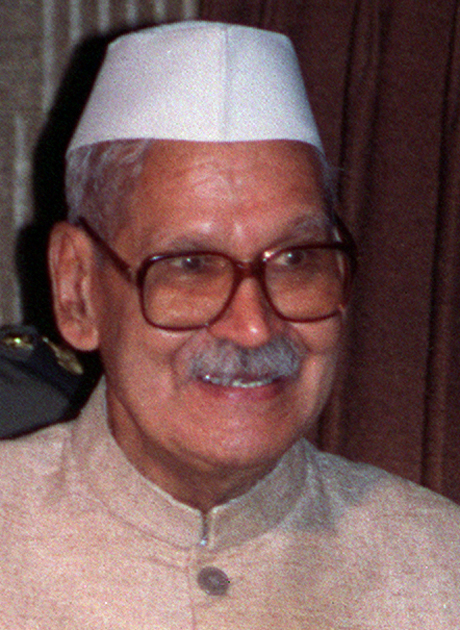
Shankar Dayal Sharma (शंकर दयाल शर्माShankar Dayal SharmaHindi) (1918-1999) was a prominent Indian lawyer and politician who served as the ninth President of India from 1992 to 1997. Born in Bhopal, he received a comprehensive education in India and abroad, including a doctorate in constitutional law from the University of Cambridge and legal qualifications from Lincoln's Inn and Harvard University. His political career began with his active participation in the Indian independence movement, for which he was imprisoned for eight months during the struggle for the merger of Bhopal State with India.
A staunch member of the Indian National Congress, Sharma held various significant positions throughout his career, including Chief Minister of Bhopal State from 1952 to 1956, and a cabinet minister in the government of Madhya Pradesh from 1956 to 1971. He also served as the president of the Indian National Congress from 1972 to 1974 and as Union Minister for Communications from 1974 to 1977. Before his presidency, Sharma served as Governor in Andhra Pradesh (1984-1985), Punjab (1985-1986), and Maharashtra (1986-1987), eventually being elected unopposed as the eighth Vice President of India in 1987.
As President, Sharma navigated a period of significant political instability, overseeing four prime ministers in his single term, three of whom he appointed in his final year. He was known for his assertive constitutional stance, particularly in his interactions with the Narasimha Rao government, forcing the resignation of a governor and taking a strong stance following the Babri Masjid demolition. He notably refused to sign certain ordinances presented on the eve of elections, asserting the principle of leaving such decisions to an incoming government. His presidency was marked by a steadfast commitment to social justice, secularism, and democratic values, as articulated in his inaugural address. Despite personal tragedy, including the assassination of his daughter and son-in-law, he upheld the rule of law. For his profound contributions to the legal field and his commitment to the rule of law, the International Bar Association honored him with the "Living Legend" award.
2. Early Life and Education
Shankar Dayal Sharma's formative years laid the groundwork for his distinguished career, characterized by a deep commitment to academia, law, and public service.
2.1. Birth and Childhood
Shankar Dayal Sharma was born on August 19, 1918, in Amon village, within Bhopal, which was then the capital of the princely state of Bhopal. He was born into a Hindu Gaur Brahmin family. He completed his early schooling in Bhopal.
2.2. Education and Early Legal Career
Sharma pursued extensive academic studies, initially attending St. John's College, Agra, and later the University of Allahabad and the University of Lucknow. He earned a MA in English, Hindi, and Sanskrit, and an LL.M.. He achieved top honors in both his MA and LL.M. courses and was awarded the Chakravarty Gold Medal for his contributions to social service. Athletically, he was a three-time swimming champion at Lucknow University and a cross country running champion at Allahabad.
His advanced legal education took him to the University of Cambridge, where he earned a doctorate in constitutional law for his thesis titled Interpretation of Legislative Powers under Federal Constitutions. While at Cambridge, he was actively involved in student life, serving as the treasurer of both the Tagore Society and the Cambridge Majlis. He also received a diploma in public administration from the University of London. He studied law at Fitzwilliam College and the University of Zurich. In 1946, he was admitted to Lincoln's Inn as a bar-at-law and taught at Cambridge University from 1946 to 1947. The following year, he was appointed a Brandeis Fellow at Harvard University. During his tenure as Vice-Chancellor of India, he also served as Chancellor for numerous Indian universities.
Sharma began his legal practice in Lucknow in 1940, where he also taught law at the university. During this period, he joined the Indian National Congress, marking the beginning of his lifelong association with the party and his involvement in the struggle for India's independence.
3. Political Career
Shankar Dayal Sharma's political career spanned over five decades, marked by his unwavering commitment to India's democratic ideals and his ascent through various state and national offices, culminating in the presidency.
3.1. Involvement in Indian Independence Movement
Sharma's political journey began in the 1940s with his active participation in the movement for India's independence from British rule. He joined the Indian National Congress, remaining loyal to the party throughout his life, and became an early advocate for nationalism and self-governance.
3.2. Early Political Career in Bhopal State
After India gained independence, the Nawab of Bhopal initially sought to maintain the princely state of Bhopal as a separate entity within the Dominion of India. Shankar Dayal Sharma emerged as a key leader in the popular movement advocating for the merger of Bhopal State with the Indian Union. In December 1948, he led widespread public protests against the Nawab's stance, which ultimately resulted in his arrest. On January 23, 1949, Sharma was sentenced to eight months of imprisonment for violating restrictions on public meetings. However, the growing public pressure and the intervention of V. P. Menon compelled the Nawab to release Sharma and sign the Instrument of Accession on April 30, 1949, thus merging Bhopal State with the Indian Union. The princely state was subsequently reconstituted as Bhopal State, a part 'C' State under the administration of a Chief Commissioner.
Following the merger, Sharma was elected to the Legislative Assembly of Bhopal from the Berasia in the 1952 elections. He assumed the office of Chief Minister of Bhopal State in 1952, becoming the youngest person to hold that position at the time. He also served as the president of the Bhopal State Congress from 1950 to 1952. He continued as Chief Minister until 1956 when, following the reorganization of states, Bhopal State was merged with several other states to form the new state of Madhya Pradesh. Sharma played a crucial role in ensuring that Bhopal was designated as the capital of this newly formed state.
3.3. Political Career in Madhya Pradesh
After the formation of Madhya Pradesh, Shankar Dayal Sharma continued his political career in the state. He was elected to the Madhya Pradesh Legislative Assembly from Udaipura in the state assembly elections of 1957, 1962, and 1967 as a candidate of the Congress party. During this period, he served as a cabinet minister in the Madhya Pradesh government, holding various important portfolios including education, law, public works, industry and commerce, and revenue.
As the Minister for Education, Sharma emphasized the importance of secular pedagogy in schools. Under his leadership, school textbooks were revised to remove religious bias and promote an inclusive educational environment. From 1967 to 1968, he served as the president of the Madhya Pradesh Congress Committee. He was also the general secretary of the Congress party from 1968 to 1972. During the 1969 split within the Indian National Congress, Sharma firmly sided with Indira Gandhi. Although initially removed from party posts by the then-party president S. Nijalingappa, he was subsequently reappointed by Indira Gandhi to her faction of the party, demonstrating his close alignment with her leadership.
3.4. Parliamentary Career
Shankar Dayal Sharma entered national politics when he was elected to the Lok Sabha from the Bhopal constituency in the general elections of 1971. The following year, in 1972, Prime Minister Indira Gandhi appointed him as the President of the Indian National Congress. Prior to this appointment, Sharma had been a member of the influential Congress Working Committee since 1967 and the General Secretary of the Congress party since 1968.
As the Congress President, Sharma launched a significant public campaign against the CIA, accusing it of actively fomenting violence in India. In October 1974, he was appointed Union Minister for Communications in the Indira Gandhi ministry, and D. K. Barooah succeeded him as the Congress party president. Sharma remained in this ministerial position until his defeat in the general election of 1977 by Arif Beg. However, he was re-elected from Bhopal in the general election of 1980, demonstrating his continued political resilience and support base.
3.5. Gubernatorial Tenures
Shankar Dayal Sharma's period as a state governor from 1984 to 1987 was marked by his adherence to constitutional principles, even amid political crises and personal tragedy.
3.5.1. Governor of Andhra Pradesh
Sharma was appointed Governor of Andhra Pradesh on August 24, 1984, succeeding Thakur Ram Lal amid a major political crisis. On August 15, 1984, Ram Lal had controversially dismissed N. T. Rama Rao, the then Chief Minister of Andhra Pradesh and leader of the Telugu Desam Party (TDP), despite Rama Rao's claim of majority support in the Assembly. Ram Lal then appointed N. Bhaskara Rao, the former finance minister under Rama Rao, as the new Chief Minister, granting him a month to prove his majority. Widespread public protests and accusations of impropriety led to Ram Lal's resignation.
Upon assuming office, Governor Sharma sought to resolve the constitutional impasse. He convened a session of the Assembly on September 11, 1984. As N. Bhaskara Rao failed to prove his majority within the stipulated one-month period, Sharma suggested that he resign, effective September 16. When Bhaskara Rao refused, seeking a reconvening of the Assembly a few days later, Sharma dismissed him and reappointed N.T. Rama Rao as Chief Minister. Rama Rao successfully won a vote of confidence when the Assembly reconvened on September 20, 1984. Shortly thereafter, the Rama Rao government called for fresh elections, and Sharma dissolved the Assembly in November 1984.
In the Assembly election of 1985, the TDP secured a two-thirds majority, and Rama Rao returned as Chief Minister. A few months later, relations between Sharma and the state government soured when he refused to repromulgate three ordinances sent to him by the Rama Rao government. These ordinances pertained to the abolition of offices of part-time village officers, the formation of districts, and the payment of salaries and removal of disqualifications of government employees. Sharma stated that ordinances require ratification by the legislature and that their repeated repromulgation would constitute a constitutional impropriety, thus asserting his constitutional limits on executive power.
On July 31, 1985, a profound personal tragedy struck Sharma: his daughter, Gitanjali, and his son-in-law, the Congress politician Lalit Maken, were assassinated by Sikh militants outside their Kirti Nagar residence in West Delhi. The attack was carried out by Harjinder Singh Jinda, Sukhdev Singh Sukha, and Ranjit Gill 'Kuki', in retaliation for Maken's alleged involvement in the 1984 anti-Sikh riots. While Gitanjali was caught in the crossfire, Maken was specifically targeted for his alleged role in the killing of around 3,000 Sikhs during the riots. After this tragic event, Sharma was transferred to Punjab as governor, and Kumudben Joshi succeeded him in Andhra Pradesh.
3.5.2. Governor of Punjab
Shankar Dayal Sharma succeeded Hokishe Sema as Governor of Punjab in November 1985. His appointment came in the aftermath of the assembly elections in the state and against the backdrop of the Rajiv-Longowal Accord, which aimed to resolve the ongoing insurgency in Punjab. Sharma's tenure as Governor was characterized by continued violence and political unrest due to the complex security situation. He served in this challenging role until April 1986, when he was replaced by Siddhartha Shankar Ray. During this period, he also concurrently served as the Administrator of Chandigarh.
3.5.3. Governor of Maharashtra
In April 1986, Shankar Dayal Sharma was sworn in as Governor of Maharashtra. His tenure in this state was relatively brief, lasting until September 1987, when he resigned from the gubernatorial post after being elected unopposed as the vice president of India.
3.6. Vice President of India
Shankar Dayal Sharma was nominated by the Congress party as its candidate for the vice-presidential election of 1987. Despite 27 candidates filing nominations, only Sharma's nomination was found valid by the returning officer. Consequently, he was declared elected unanimously on August 21, 1987, making him only the third person in India's history to be elected unopposed to the vice-presidency. He was sworn in as Vice President of India on September 3, 1987. During his term as Vice President, he concurrently held the position of Vice-Chancellor for many Indian universities.
As Vice President, Sharma also served as the ex-officio chairman of the Rajya Sabha, India's upper house of Parliament. In February 1988, he notably offered to resign from this position after his ruling, which admitted a discussion in the house regarding the purported extravagance of the then-Governor of Andhra Pradesh, met with vociferous objections from government members. Despite Prime Minister Rajiv Gandhi's presence in the house and his choice not to intervene or restrain his party members, Sharma's firm response chastened the protesting members. He subsequently refused their request to expunge the proceedings from Parliament records, upholding parliamentary decorum and his constitutional role.
In 1991, following the tragic assassination of Rajiv Gandhi, Sonia Gandhi offered Sharma the presidency of the Congress party and the post of Prime Minister. However, he declined both offers, citing his deteriorating health and advanced age. Subsequently, P. V. Narasimha Rao was chosen to lead the Congress party and eventually became Prime Minister.
3.7. President of India
Shankar Dayal Sharma's presidency (1992-1997) was a period of significant political and social transformation in India, during which he often played a crucial constitutional role, particularly in navigating coalition politics and communal tensions.
3.7.1. Presidential Election and Inauguration
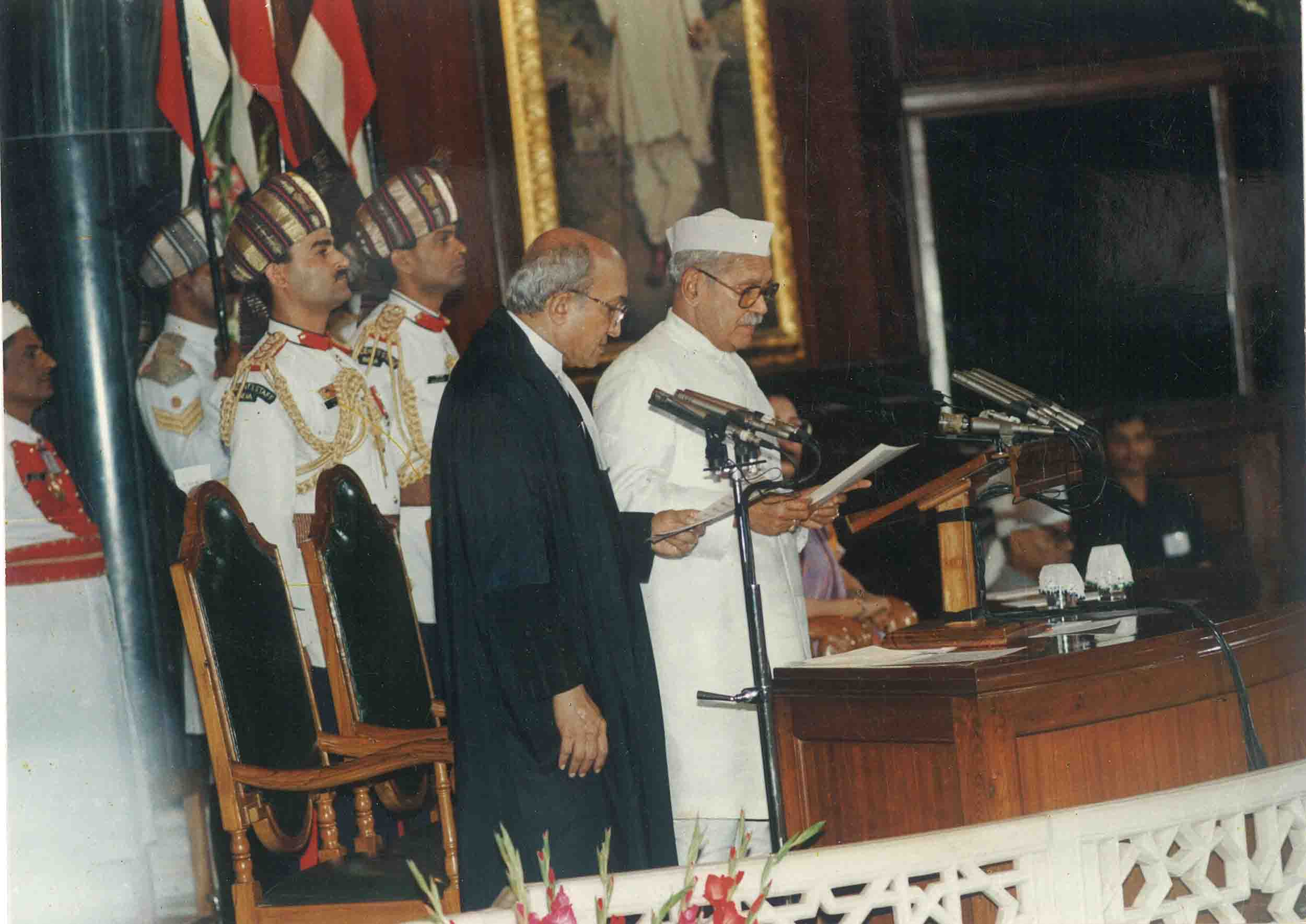
In June 1992, the Congress party selected Shankar Dayal Sharma as its candidate for the presidential election to succeed Ramaswamy Venkataraman. His nomination received crucial support from various communist parties, broadening his political backing. The election was held on July 13, 1992, with votes counted three days later. Sharma secured a decisive victory, polling 675,804 votes (approximately 66% of the electoral college vote) against his main opponent, George Gilbert Swell, the nominee of the opposition Bharatiya Janata Party, who received 346,485 votes. Two other candidates, Ram Jethmalani and Kaka Joginder Singh, garnered a small number of votes. Sharma was officially declared elected on July 16, 1992, and was sworn in as the ninth President of India on July 25, 1992.
In his inaugural address, President Sharma articulated his core vision for India, stating that "Freedom has little meaning without equality and equality has little meaning without social justice." He committed his presidency to combating critical national challenges, including terrorism, poverty, disease, and communalism. The validity of his election was subsequently challenged before the Supreme Court of India, but the challenge was unsuccessful.
3.7.2. Narasimha Rao Government
President Sharma's election was perceived as a victory for the Congress party and Prime Minister P. V. Narasimha Rao, who led a minority government at the time. Although the office of the President in India is largely ceremonial, it holds significant constitutional importance, particularly in situations of a hung Parliament or when a government loses a vote of confidence, as the President is responsible for nominating a new head of government. During its tenure, the Rao ministry faced three no-confidence motions, the third of which, in July 1993, was marred by serious allegations of bribery and subsequent criminal indictment against Rao himself.
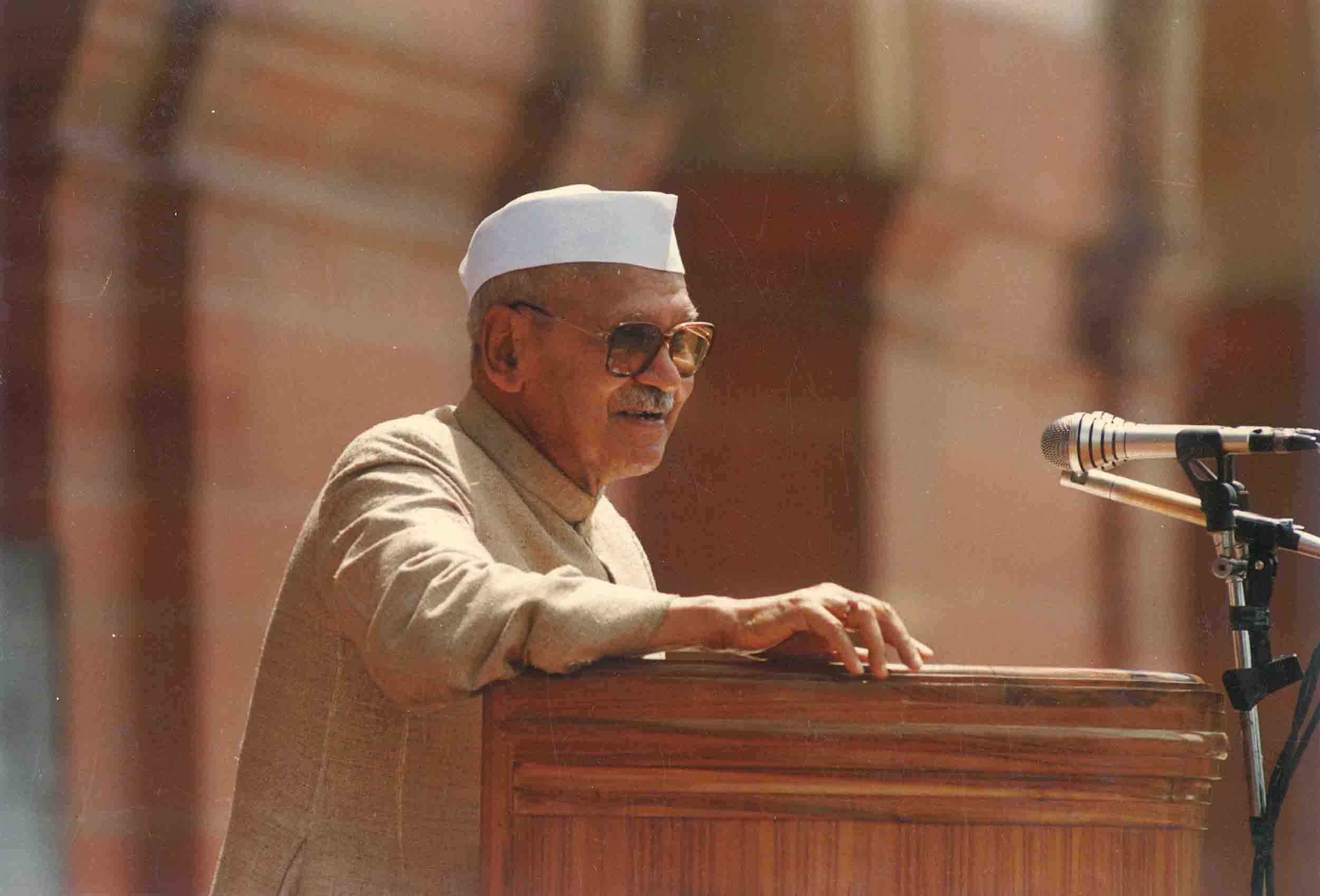
A pivotal moment during Sharma's presidency occurred on December 6, 1992, when the Babri Masjid in Ayodhya was demolished by a fanatic Hindu mob, leading to widespread communal rioting across India. President Sharma publicly expressed his deep anguish and pain at the demolition, condemning the act as being contrary to India's traditional ethos of respecting all religions and the fundamental precepts of Hinduism. His strong condemnation prompted the Rao government to swiftly dismiss the state government of Uttar Pradesh, where Ayodhya is located, and impose President's rule on the same evening. The following day, the Government of India, by means of a presidential ordinance, acquired 67 acre (67 acre) of land in and around the site where the mosque had stood, stipulating that all litigation related to the disputed area would be dissolved following the acquisition. In January 1993, Sharma made a reference to India's Supreme Court, seeking an opinion on whether a Hindu temple or religious structure had existed prior to the construction of the Babri Masjid at the disputed Ram Janmabhoomi site. However, in 1994, the Supreme Court, by a majority decision, declined to answer the reference, deeming it contrary to the spirit of secularism and potentially favoring a particular religious community.
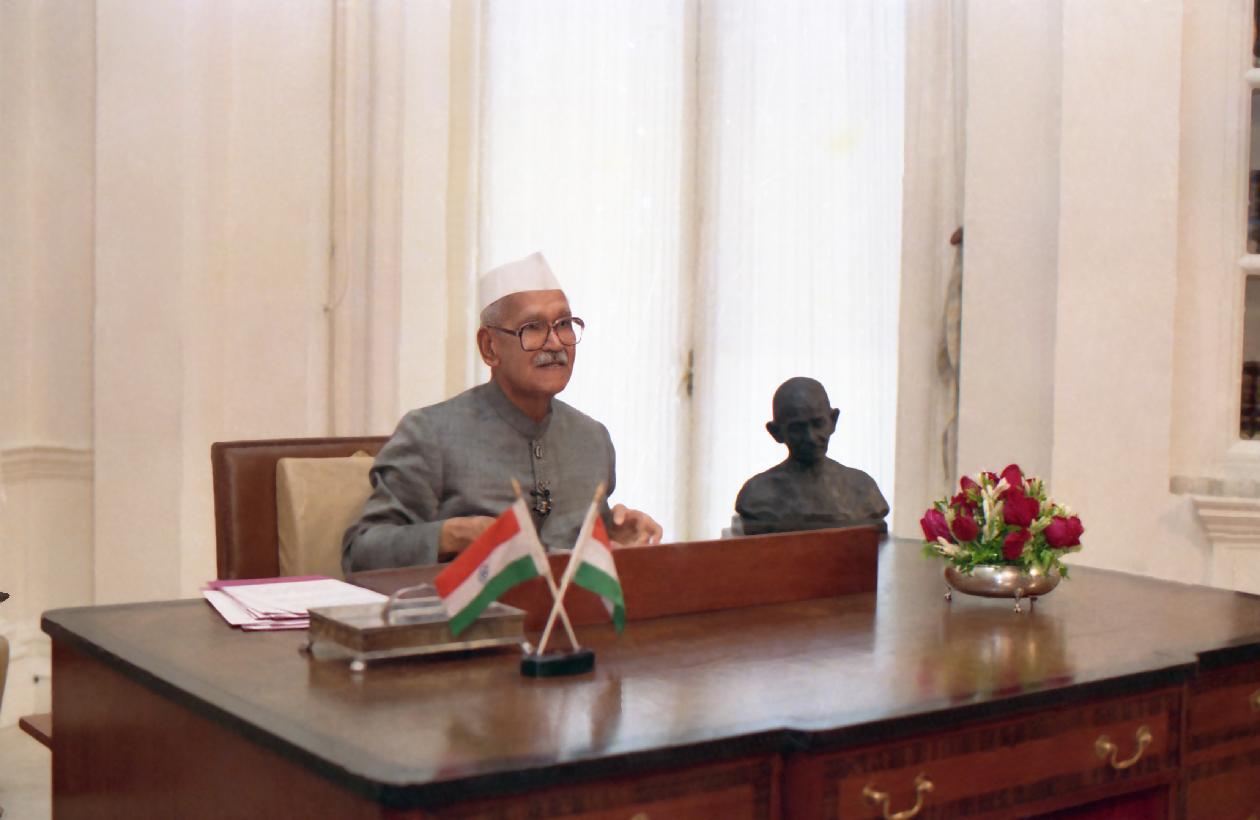
In 1995, President Sharma dedicated the reconstructed Somnath temple in Gujarat to the Indian people. During the dedication ceremony, he reiterated his belief that all religions teach the same lesson of unity and that humanism transcends all other considerations. The construction of the temple had spanned five decades and had been a subject of ongoing debate concerning its financing, the role of the state in its reconstruction, and the presence of constitutional functionaries during the installation of the idol, all of which raised significant questions about India's secular character since its independence.
President Sharma generally maintained cordial relations with the Narasimha Rao government. However, in 1995, he demonstrated his constitutional assertiveness by compelling the government to seek the immediate resignation of Sheila Kaul, the governor of Himachal Pradesh. This action came after the Supreme Court expressed concern that Kaul was leveraging her gubernatorial immunity to evade criminal proceedings. In 1996, on the eve of general elections, Sharma returned two ordinances sent to him by the Rao government. These ordinances aimed to extend the benefits of reservations in state employment and education to Christian and Muslim Dalits and to reduce the time allowed for election campaigning. Sharma justified his refusal on the grounds that such significant policy decisions, given the impending elections, should rightfully be left to the incoming government, thereby upholding democratic propriety.
3.7.3. Vajpayee, Deve Gowda, and Gujral Governments
Sharma's final year in office was marked by unprecedented political fluidity, requiring him to exercise his constitutional powers in appointing three prime ministers due to successive hung Parliaments.
Following the general elections of 1996, no single party secured a clear majority in Parliament. The Bharatiya Janata Party (BJP) emerged as the single largest party with 160 seats out of 543, while the ruling Congress party came second with 139 seats. On May 15, 1996, President Sharma invited Atal Bihari Vajpayee, as the leader of the single largest party, to form the government, with the condition that he prove his majority on the floor of the house by May 31. Vajpayee and a cabinet of 11 ministers were sworn in the following day. President Sharma addressed the new Parliament on May 24. This address, provided for under Article 87 of India's constitution, outlines the government's policy and plans and is typically followed by a motion of thanks. However, in 1996, to avoid a political crisis, no motion of thanks was moved on this address given the Vajpayee government's swift resignation and the subsequent Deve Gowda ministry's disagreement with its contents. However, during the motion for a vote of confidence, which was debated on May 27 and 28, Vajpayee announced his resignation before the motion could be put to a vote. This resulted in the government lasting only 13 days, making it the shortest tenure for a Prime Minister in India's history.
President Sharma's decision to invite Vajpayee to form the government drew criticism from various quarters. Unlike previous Presidents such as Ramaswamy Venkataraman or Neelam Sanjiva Reddy, who had requested prime ministerial candidates to provide lists of their supporting MPs to satisfy themselves of their majority, Sharma did not make such demands of Vajpayee. Instead, he appointed Vajpayee solely based on the principle of inviting the leader of the largest party. Furthermore, Sharma did not issue any press communiqués to explain the rationale behind his decision, unlike his predecessors. Communist parties, which had supported Sharma's presidential bid, particularly criticized his decision to invite their ideological opponent, the BJP, to form the government. However, Sharma's decision was also attributed to the fact that no other party had immediately staked a claim to form the government, and the United Front, a coalition of thirteen parties, took time to decide on their leader and secure support from the Congress party. The two-week deadline given to Vajpayee to prove his majority was also considerably shorter than in previous instances, a measure intended to discourage horse trading among legislators.
Following Vajpayee's resignation, President Sharma asked him to continue as a caretaker prime minister. On May 28, 1996, after receiving assurances of support from the Congress party for his candidature, Sharma appointed H. D. Deve Gowda as prime minister. Gowda and a 21-member council of ministers were sworn in on June 1 and successfully won a vote of confidence within the 12-day deadline set by Sharma. Gowda, a former chief minister of Karnataka, became India's third prime minister in as many weeks and led a diverse coalition comprising regional parties, leftists, and lower caste Hindu politicians. He was also notable as India's first prime minister not conversant in its official language, Hindi. Gowda's government lasted ten months, its survival dependent on the support of the Congress party. In April 1997, the Congress party, under its new president Sitaram Kesri, withdrew its support, alleging that the prime minister had failed to prevent the growth of Hindu nationalist political parties in North India. Sharma then directed Gowda to seek a vote of confidence in Parliament. Gowda lost the vote of confidence on April 11, 1997, and continued to head a caretaker government while President Sharma deliberated on the next course of action.
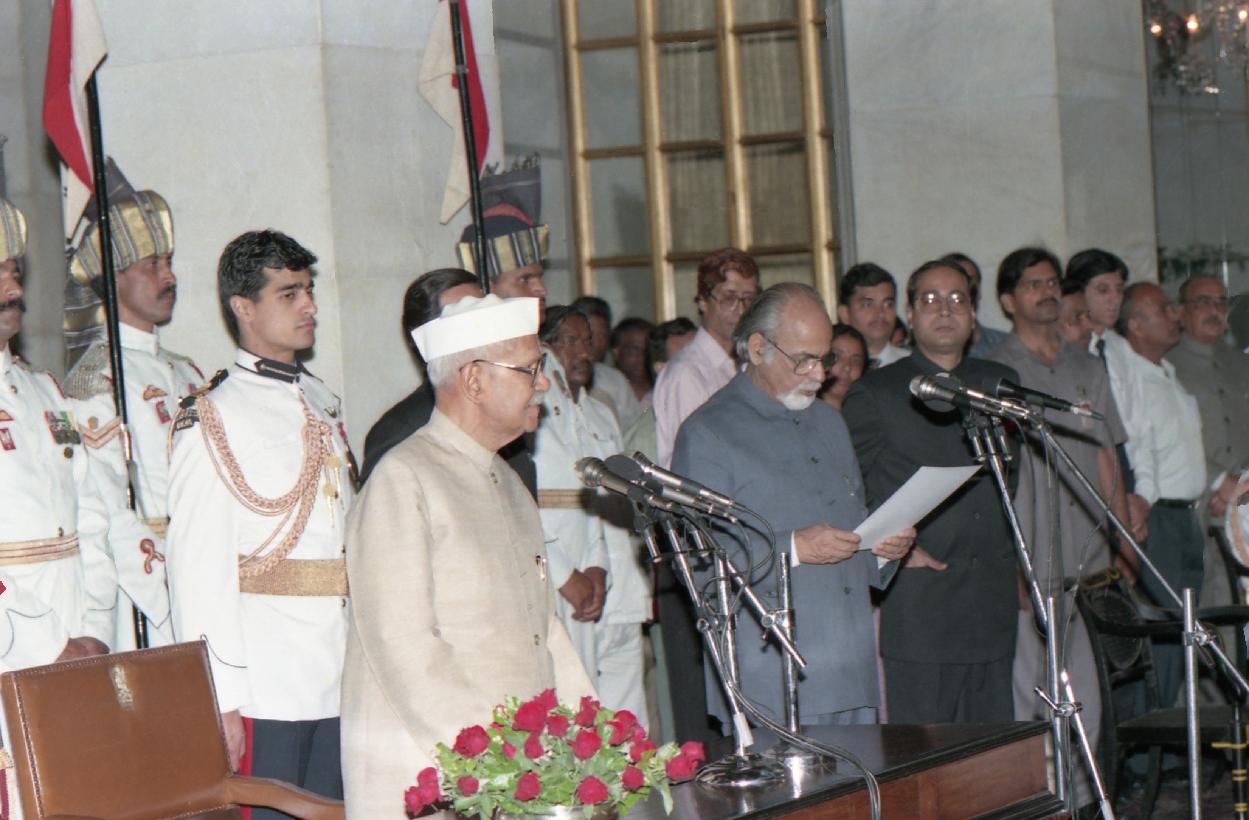
On April 21, 1997, Inder Kumar Gujral, who had served as the foreign minister under Deve Gowda, was sworn in as prime minister. He was given two days to win a vote of confidence in Parliament. Gujral was the third prime minister to be sworn in by President Sharma during his single term. His government lasted 322 days before the Congress party once again withdrew its support from the United Front ministry. At the conclusion of his term, President Sharma opted not to seek a second term in office. He was succeeded in the presidency by then-Vice President K. R. Narayanan.
3.7.4. State Visits
During his presidency, Shankar Dayal Sharma undertook numerous significant state visits, fostering diplomatic ties and strengthening India's international relations. These included visits to Bulgaria, Chile, the Czech Republic, Greece, Hungary, Italy, Namibia, Oman, Poland, Romania, Slovakia, Trinidad and Tobago, Turkey, Ukraine, the United Kingdom, and Zimbabwe.
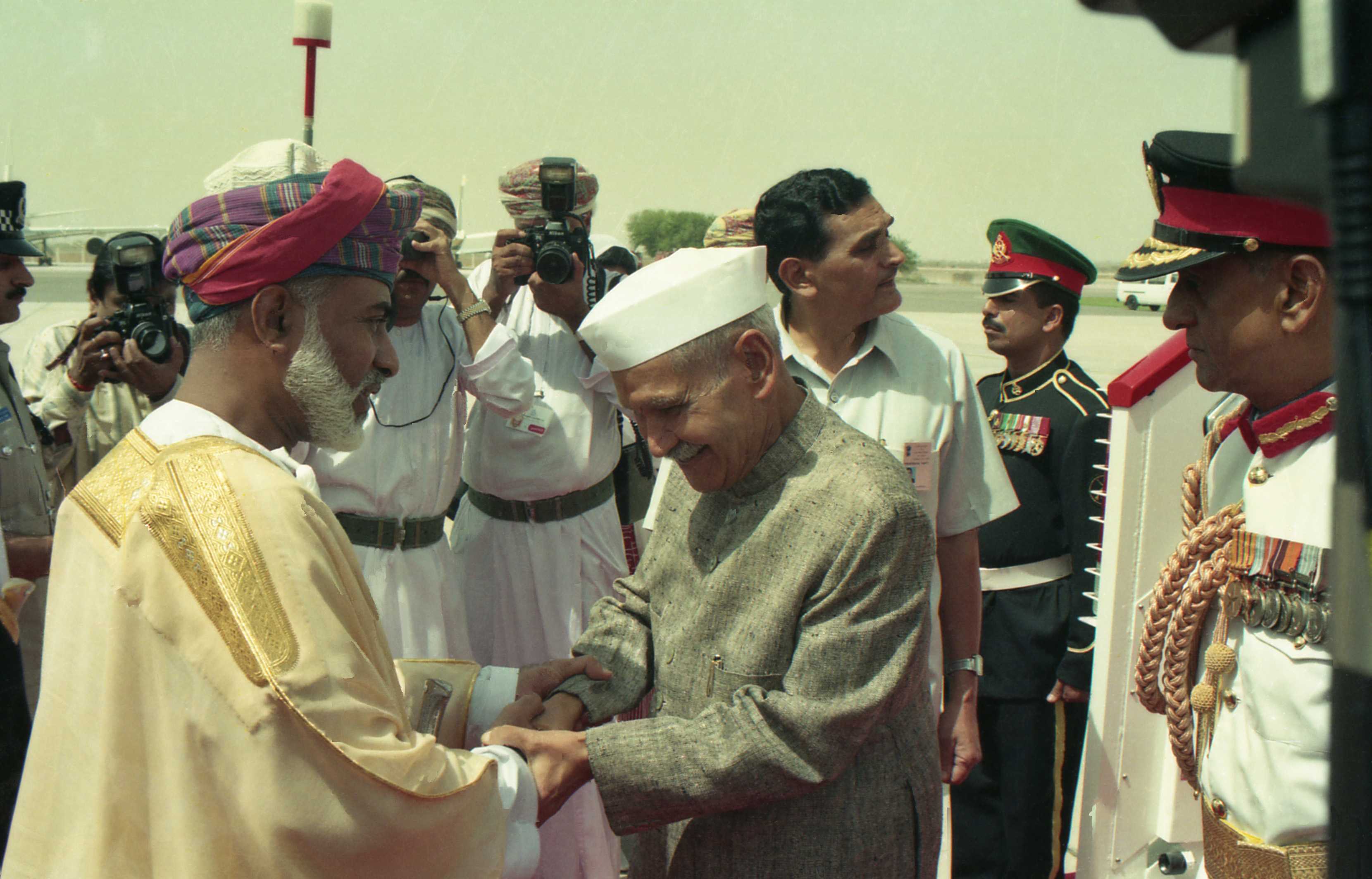
A particularly notable visit was to Oman in 1996, where Sultan Qaboos personally received President Sharma at the airport, setting aside diplomatic protocol. Sultan Qaboos famously silenced critics by stating that he had come to receive his "guru." This exceptional gesture stemmed from a personal connection: Qaboos had received his secondary education in Pune, India, where Sharma had privately tutored him. In 1996, Zimbabwe presented India with a diplomatic gift of a pair of African elephants. The male elephant, named Shankar in honor of President Sharma, resides alone in the Delhi Zoo following the death of its companion, Bombai, in 2005. The plight of the elephant has been taken up by animal rights activists, leading the Delhi High Court to order the zoo to explore options for acquiring a female companion for Shankar.
4. Personal Life
Shankar Dayal Sharma was married to Vimala Sharma from 1950 to 1999. They had two sons and two daughters. His family life was marked by a profound tragedy on July 31, 1985, when his daughter, Gitanjali, and his son-in-law, Congress politician Lalit Maken, were assassinated by Sikh militants outside their residence in Kirti Nagar, West Delhi. The militants, including Harjinder Singh Jinda, Sukhdev Singh Sukha, and Ranjit Gill, targeted Lalit Maken for his alleged role in the 1984 anti-Sikh riots, which resulted in the deaths of approximately 3,000 Sikhs. Gitanjali was unfortunately caught in the crossfire during the attack.
In a twist of fate, during his presidency, Shankar Dayal Sharma faced the difficult decision of considering the mercy petitions filed by Jinda and Sukha, two of his daughter and son-in-law's killers. Exercising his constitutional power to pardon under Article 72 of the Indian Constitution, President Sharma rejected all mercy petitions that came before him during his entire presidential tenure, including those of his family's assassins. Consequently, both Jinda and Sukha were executed. Ranjit Gill, the third individual involved, was arrested in 2003 and initially sentenced to life imprisonment, a sentence that was later commuted with the consent of Maken's daughter, Avantika.
5. Death and Funeral
Shankar Dayal Sharma's health had been declining during the last five years of his life. On December 26, 1999, he suffered a severe heart attack and was admitted to the Escorts Heart Institute in Delhi, where he passed away at the age of 81. In recognition of his service to the nation, the Government of India declared seven days of national mourning in his honor. A state funeral was accorded to him, and he was cremated on December 27, 1999. His samadhi, a memorial shrine, is located at Karma Bhumi in Delhi.
6. Assessment and Impact
Shankar Dayal Sharma's legacy is defined by his deep legal scholarship, his commitment to democratic principles, and his unwavering emphasis on social justice and secularism, which he championed throughout his political career.
6.1. Ideological Contributions and Social Impact
Sharma's contributions to Indian society and governance were deeply rooted in his ideological convictions. As Minister for Education in Madhya Pradesh, he took concrete steps to promote secular pedagogy by revising school textbooks to eliminate religious bias, laying a foundation for an inclusive education system. In his inaugural address as President, he stressed that "Freedom has little meaning without equality and equality has little meaning without social justice," thereby articulating a core tenet of his philosophy. He explicitly committed his presidency to combating critical societal ills such as terrorism, poverty, disease, and communalism. His dedication of the reconstructed Somnath temple to the Indian people was accompanied by his assertion that all religions teach a unifying lesson and that humanism should be prioritized above all else, underscoring his deep commitment to pluralism and interfaith harmony. His contributions to the legal field and his steadfast commitment to the rule of law were globally recognized.
6.2. Honors and Commemoration
Shankar Dayal Sharma received numerous honors and widespread commemoration for his distinguished service and intellectual contributions. In 1993, he was made an honorary bencher and Master of Lincoln's Inn, a prestigious recognition from the legal fraternity where he had previously studied. He was conferred with an honorary degree of Doctor of Law by the University of Cambridge, his alma mater. Additionally, he received honorary doctorates from several other esteemed international institutions, including Sofia University, the University of Bucharest, and the Taras Shevchenko National University of Kyiv, as well as numerous Indian universities.
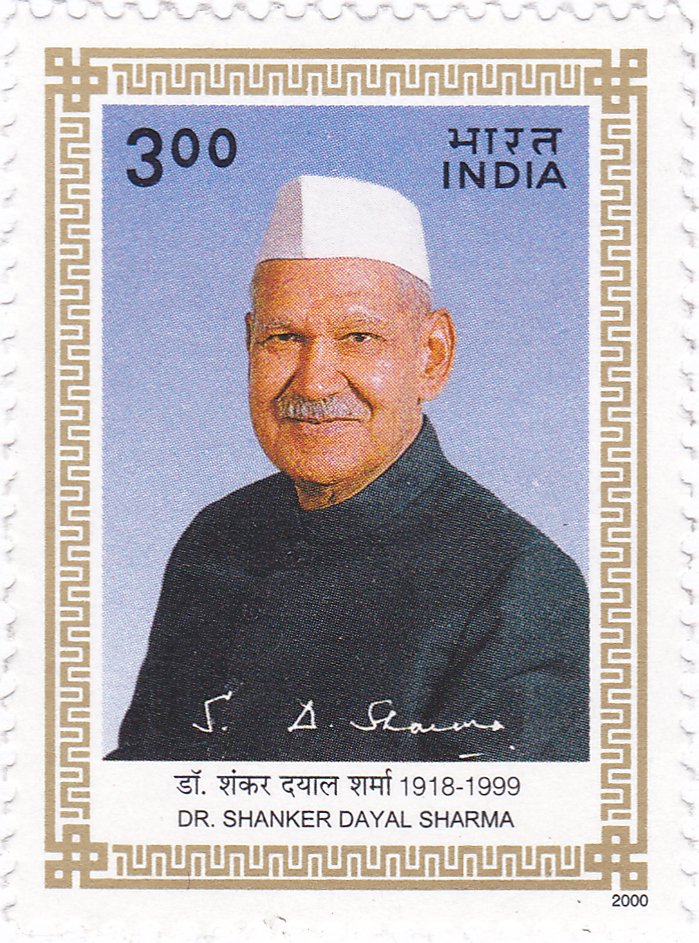
His life and presidency were chronicled in "Dr. Shankar Dayal Sharma," a 1999 short documentary feature produced by the Government of India's Films Division, directed by A. K. Goorha. In 2000, India Post issued a commemorative postage stamp in his honor, further cementing his place in national memory. Several institutions in India have been named after him, including the Dr. Shankar Dayal Sharma Ayurvedic College & Hospital and the Dr. Shankar Dayal Sharma College, both located in Bhopal. In 2009, the Dr. Shankar Dayal Sharma Institute of Democracy was inaugurated under the University of Lucknow, dedicated to promoting democratic values and education. The Shankar Dayal Sharma Gold Medal, funded by endowments made by Sharma himself, was instituted in 1994 and is awarded annually at several universities across India to recognize outstanding achievements.
6.3. Publications and Editorships
Shankar Dayal Sharma was a prolific writer, authoring several books in both English and Hindi. His published works include:
- The Congress Approach to International Affairs
- Studies in Indo-Soviet cooperation
- Rule of Law and Role of Police
- Jawaharlal Nehru: The Maker of Modern Commonwealth
- Eminent Indians
- Chetna Ke Strot (Hindi)
- Hindi Bhasha Aur Sanskriti (Hindi)
He also held significant editorial roles, serving as the editor of:
- Lucknow Law Journal
- Socialist India
- Jyoti
- Ilm-o-Nur